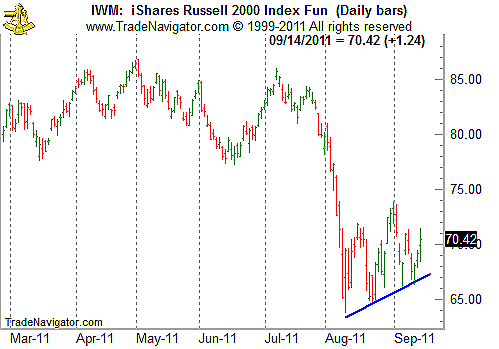
HOT TOPICS LIST
- MACD
- Fibonacci
- RSI
- Gann
- ADXR
- Stochastics
- Volume
- Triangles
- Futures
- Cycles
- Volatility
- ZIGZAG
- MESA
- Retracement
- Aroon
INDICATORS LIST
LIST OF TOPICS
PRINT THIS ARTICLE
by Mike Carr, CMT
The current decline in stocks has hit smaller stocks more than larger ones.
Position: Buy
Mike Carr, CMT
Mike Carr, CMT, is a member of the Market Technicians Association, and editor of the MTA's newsletter, Technically Speaking. He is also the author of "Smarter Investing in Any Economy: The Definitive Guide to Relative Strength Investing," and "Conquering the Divide: How to Use Economic Indicators to Catch Stock Market Trends."
PRINT THIS ARTICLE
CHART ANALYSIS
Small Caps Are Riskier Than Large Caps
09/15/11 08:50:06 AMby Mike Carr, CMT
The current decline in stocks has hit smaller stocks more than larger ones.
Position: Buy
| Risk and return are invariably related and greater returns come with greater risk. Numerous studies have demonstrated that small-cap stocks outperform large-cap stocks in the long term. These same studies also show that risk, measured by standard deviation in most academic studies, is great for small caps. In the language of a trader, small-cap stocks will deliver more bang for the buck in both bull and bear markets. |
| Figure 1 shows IWC, an exchange traded fund (ETF) that tracks the Russell Microcap Index, which is the smallest of the small caps. This index is still more than 20% below its high and it dropped more relative to indexes of larger stocks. |

|
| FIGURE 1: IWC, DAILY. IWC fell sharply but is near a breakout point after potentially forming a base with a triple bottom. |
| Graphic provided by: Trade Navigator. |
| |
| Figure 1 also includes the relative performance of OEF, an ETF that tracks the large-cap Standard & Poor's 100, and IWM, an ETF tracking the Russell 2000, along with IWC. OEF is the strongest since the decline, because it declined the least. |
| Smaller stocks generally have wider spreads and less liquidity, which increases trading costs. An interesting point in that chart is that IWC and IWM deliver similar returns. Given that, the added cost of trading microcaps may not be worth it. |

|
| FIGURE 2: IWM, DAILY. IWM has a more visible rising trendline in its bottoming pattern than IWC. |
| Graphic provided by: Trade Navigator. |
| |
| Given the stronger pattern, IWM (Figure 2) may offer the greatest potential return of these three ETFs if the market continues higher. |
Mike Carr, CMT, is a member of the Market Technicians Association, and editor of the MTA's newsletter, Technically Speaking. He is also the author of "Smarter Investing in Any Economy: The Definitive Guide to Relative Strength Investing," and "Conquering the Divide: How to Use Economic Indicators to Catch Stock Market Trends."
| Website: | www.moneynews.com/blogs/MichaelCarr/id-73 |
| E-mail address: | marketstrategist@gmail.com |
Click here for more information about our publications!
Comments
Date: 09/15/11Rank: 5Comment: What I find interesting Mike is that the small caps are not leading this rally yet which is somewhat unusual. Small caps tend to lead in real rallies... don t they?

|

Request Information From Our Sponsors
- StockCharts.com, Inc.
- Candle Patterns
- Candlestick Charting Explained
- Intermarket Technical Analysis
- John Murphy on Chart Analysis
- John Murphy's Chart Pattern Recognition
- John Murphy's Market Message
- MurphyExplainsMarketAnalysis-Intermarket Analysis
- MurphyExplainsMarketAnalysis-Visual Analysis
- StockCharts.com
- Technical Analysis of the Financial Markets
- The Visual Investor
- VectorVest, Inc.
- Executive Premier Workshop
- One-Day Options Course
- OptionsPro
- Retirement Income Workshop
- Sure-Fire Trading Systems (VectorVest, Inc.)
- Trading as a Business Workshop
- VectorVest 7 EOD
- VectorVest 7 RealTime/IntraDay
- VectorVest AutoTester
- VectorVest Educational Services
- VectorVest OnLine
- VectorVest Options Analyzer
- VectorVest ProGraphics v6.0
- VectorVest ProTrader 7
- VectorVest RealTime Derby Tool
- VectorVest Simulator
- VectorVest Variator
- VectorVest Watchdog
